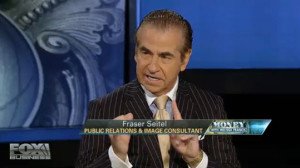“As I looked at the aggressive nature of our plan, there was a set of people who didn’t fit the plan or didn’t have the right skill set or didn’t have the right attitude. We’re hiring like crazy for growth, so let’s get the wrong people off the bus.”
Executive Summary
CEOs often refer to employees as their “most valuable asset,” but their public comments can belie that view. Patrick Hirigoyen, a veteran in public relations and corporate communications, interviewed his peers in the industry who revealed public comments from executives that lowered company morale. Here, he also presents expert tips for executives dealing with their first audience—their employees.- Harsh and unnecessary.
- Risking the morale of employees still with the company.
- Sending the wrong message to prospective employees it needed to attract in a competitive economy.
The CEO forgot that, although his comments were made to a reporter outside the company, the first audience for his words was his own employees. They were sure to hear and carefully weigh what he was saying during a critical time for the firm.
How well do CEOs and others in top management communicate with their employees, who are often called a company’s first and most important audience?
Although many CEOs state that employees are a company’s most important asset and the key to success, executive communications often betray a disregard for their effects on employees.
Several corporate communications leaders and public relations experts recalled similar instances in their own experience, when chief executives didn’t fully consider how their comments affected employees—and lessons those experiences may offer to current executives.
Keep Your Promises
Fraser Seitel is a longtime New York-based public relations consultant. The author of “The Practice of Public Relations,” he is an adjunct instructor at New York University and a frequent commentator on media topics on Fox News and other outlets.
Seitel began his career in corporate communications at the Chase Manhattan Bank, eventually advancing to the top communications position. In that role he advised bank Chairman David Rockefeller, who remains a client.
One episode from early in Seitel’s career illustrates what happens when employees expect to hear from top management on an important topic but management fails to deliver—and the problems that result.

“I was in my rookie season at Chase, during the 1970s, when I edited the internal newspaper, which went to 40,000 employees,” Seitel said. “In my first several weeks on the job, a survey was distributed to all employees, and we announced we would publish the results in the company newspaper.
“About six months later, all the results were in, and they weren’t good,” he said. “Employees didn’t trust their supervisors, management wasn’t credible, and employees felt they weren’t being listened to.”
Seitel was summoned to a meeting where senior executives discussed how they would deal with the results.
“The head of human resources stood up and said: We’re not going to distribute the results,” Seitel continued. “That was the decision, period.
“But over the next several weeks the rumor mill kicked into high gear,” he added. “Everyone realized that management was scared to share the results. Morale plummeted, as there had been a complete lack of acceptance of employees as adults. There couldn’t have been a worse decision. Management’s credibility was zero.”
Seitel said the lesson of the experience has stayed with him ever since. Over time, he said, management got smarter and learned the importance of communicating with employees. Once you say something, Seitel said, you have to deliver on what you promised.
“If people inside an organization don’t believe management, people outside never will,” Seitel said. “Management’s first job is to inform and educate the employee audience.”
Become the First, Trusted Source
David Prosperi, first vice president of public relations at the Options Clearing Corp. and former vice president of global public relations at insurance and reinsurance broker Aon plc, said management needs to be the first source of news affecting employees.

“Regardless of the situation, the employee team needs to hear the news directly from the company or CEO before they read about it online or hear about it via broadcast media,” Prosperi commented. “The communication needs to be as direct and open as possible, so as to instill or maintain confidence in the decision or action that is being announced.
“And it needs to be done not only via an email but also through town halls, webcasts or small group meetings to ensure that employees have a chance to interact with the decision-makers. That has to be a critical component of any communications strategy,” he added.
Jon Austin, who provides crisis communications, media relations and other services to chief executives, had similar advice. After 10 years in corporate communications, Austin worked for an international public relations firm and has run his own consulting agency for the last 10 years.
“My stock advice to CEOs is twofold: First, get out of your office and get face to face with your people. And, second, you can never overcommunicate to employees,” Austin said.

“I realize getting out of the office is time consuming and disruptive—particularly if you have far-flung operations—but there’s no better communications medium than in person,” Austin explained, adding that it should be part of a CEO’s regular schedule and part of his or her evaluation and compensation reviews.
“As for overcommunicating, the old cliché of ‘You have to run an ad seven times before somebody will recall seeing it once’ applies to internal communications as well. People treat the intranet, the newsletter, the weekly meeting, etc., as wallpaper after a while. The only way to get through that is by repetition—and getting the CEO out in the field,” Austin said.
You’re Always “On”
Austin shared another example of a CEO’s ill-chosen comments to the news media.
“I was once staffing an interview by a CEO at a company where there had been a long-running labor dispute that was exacerbated by a downturn in the business and a struggling economy,” Austin said. “We reached out to the local paper for a wide-ranging sit-down where the CEO would try to put things in context and renew the company’s commitment to a fair contract and to managing through the business problems.
“The interview went on for an hour and was perfectly on message—probably a little boring to the reporter,” Austin continued. “The very last question, a throwaway almost, was along the lines of, ‘Is there anything else you’d want to say to somebody who’s unhappy working here?’ The CEO looked at the reporter and said, ‘If they’re unhappy, they should quit and go do something else.’
“You can guess what the headline and the lead paragraph were,” he added. “Instead of helping to calm things down, the interview set off a new round of discord and anger and marked the beginning of the end of the CEO’s tenure. While I never discussed it with him, I think the reaction to his comment started his thinking down the path of ‘I don’t need this.'”
David Monfried, who has headed corporate communications at six Fortune 200 companies, including two insurers, shared a similar story.

“A CEO I worked for was visiting New York and met with a small group of investment analysts,” Monfried said. This was early in the CEO’s tenure.
“As required by the SEC [Securities and Exchange Commission], the meeting was streamed over the Internet,” Monfried explained. “One of the analysts asked, near the end of the meeting: ‘How’s morale at the company?’ The CEO said, ‘I don’t know and I don’t care. I’m not the morale officer today.'”
Perhaps, Monfried said, the executive didn’t realize his words were being live-streamed, or perhaps he was tired and just not careful about what he said. But many employees—as well as a reporter for the newspaper in the city where the company was headquartered—were listening to the live stream.
“He learned a bitter lesson about being naïve in such situations and being unconcerned about employee morale,” Monfried added. “He issued a formal statement to employees later about the comments occurring at the ‘end of a long day,’ when he was tired, and regretting his comments. But the damage was done, and a lot of mistrust was created among employees.”
Some suggest that CEOs and other top executives can be uncomfortable with communications because they view it as a “soft” activity—in other words, something that can’t be measured and thus not important to management objectives.
Jeff Botti, whose 35-year career has included communications positions at a large insurer, recalled a meeting of a company’s communications staff with the firm’s new CEO. The purpose of the meeting was to give the communicators a preview of the new CEO’s vision and to better equip them to communicate it. The executive had talked about changing the company’s culture to one in which employees would be expected to either produce more efficiently and have good attitudes or “get off the bus.”
One communicator asked the CEO a challenging question about the effects of this cultural change on employees. The CEO began his response with: “Well, I can’t address the chip on your shoulder…”

“The comment just seemed hostile, an overreaction, and for a time it broke the trust that needs to exist between communicators and the CEO,” Botti said. “Communicators felt defensive and disrespected. Exacerbating the problem, the CEO also didn’t see a need to talk to the media.
“Over time, the CEO did put greater value on communications, including media relations and community relations,” Botti added, “But it took time to repair the CEO’s initial adversarial approach.”
Be Consistent
Years ago, corporate executives generally assumed that they could parse their messages for different audiences, focusing one set of messages, for example, on investors, with different messages for employees.
That isn’t possible anymore, commented John C. Millen, who operates Columbus, Ohio-based The Leader Room, which provides coaching, training and consulting on leadership communications. Millen’s 30-year career has included executive communications positions at three insurance companies.

“Your message needs to be consistent,” Millen explained, “though perhaps with certain nuances for different audiences.”
He offered an example of inconsistent messaging. He was working with the CEO of a very large company that was planning operational changes in its headquarters location, where it had several facilities. Those plans, executives knew, would mean relocating employees to different facilities, but the specifics had not yet been worked out and the company was not ready to release details.
“I had accompanied the CEO to meet with the business editor at the local newspaper,” Millen said. “We had information to share with the paper and had prepared various talking points, when out of the blue he just starts telling the editor about the planned move of employees. And we hadn’t yet told employees anything about this.”
Millen tried to interject, telling the editor that the moves were still in the planning stages. The CEO, however, wasn’t attentive to Millen’s signals and kept talking about the moves.
“After the interview, I ended up getting the editor to hold off on the information about office relocations in exchange for an exclusive on the announcement,” Millen said, saying the gaffe, from his standpoint as a professional communicator, felt like a “near-death experience.”
Millen talked about a similar case in which a statement by a CEO not only didn’t follow a planned “script” but also forced his company to follow through on a promise it hadn’t intended to make.
“This was a private company that had announced it would acquire a smaller firm,” said Millen, who counseled the CEO. When such a transaction occurs, Millen said, synergies and redundancies between the two firms are identified and some employees, as a result, lose their jobs. Millen had advised the CEO to stay on this message: that planning for the integration of the two firms was still in the works; that management couldn’t promise anything at the time in terms of who would continue to work for the company; and that they would work as hard as they could to minimize job losses.
“So the CEO is conducting a Q&A session with employees, and the first question is, who will lose their jobs as a result of the acquisition?” Millen said. “And the CEO just says, ‘No one is losing their jobs!'”
As a result, Millen continued, the company couldn’t initiate any immediate layoffs as a result of the acquisition without risking the credibility of senior management. “Instead, over the longer term, the company tried to find other jobs within the organization for employees considered redundant,” he said. “As the workforce was reduced through attrition, the job reductions took longer than anticipated, and the synergies came more slowly, because the company had to follow through on the CEO’s promise.”
Connect With the Emotion
Ted Murphy suggests that executives should tackle these situations by following a common thread based on three words: feel, think, do.
Murphy has worked in public relations and communications since 1972. His employers have included a professional association and three urban school districts, as well as an international public relations firm. As an independent practitioner since 1993, he has counseled corporate executives around the globe.

“As they approach such crucial or difficult conversations, executives often spend the bulk of their time developing their message points,” he said, in a process that can involve communications and legal staff as well as other executives.
“Instead, they need to spend more time focusing on what message the audienceis hearing, and the first question they need to ask is, what do we want employees to feel?”
That means, he said, acknowledging the employee’s feelings and emotions up front and teeing up the bad news with a statement such as, “This is a very difficult conversation, and I know it’s difficult for you to hear.”
“The sooner your message intersects with the emotions of the audience, the more effective the communication,” Murphy said. “If it’s a tough situation, and you, the executive, understand that, it increases the effectiveness of all your communications.”
Murphy said the second step, “think,” is where most corporate communicators focus their efforts, on the content of the message. Executives and their communications staff, he said, try to make sure they choose the right word, the correct language in talking with employees.
“But by itself, I think that approach is short-sighted. Of course your message is important, but you can easily miss the key ingredient in the first step: what you want the employee to feel,” Murphy added.
Then comes “do”—what you want the employee to do next. This may, for example, mean getting the employee to think about his or her job skills and begin thinking about possible opportunities elsewhere.
“When talking with employees about matters such as layoffs, you’re not just communicating; you’re dealing with someone’s life,” Murphy said.
Unprecedented Potential
The experts agreed that, with the advent of social media and mobile communications technologies, executive communications have changed dramatically.
“In the digital age, you’re not just talking with employees,” Murphy said, “even if they’re your immediate audience. They’re the primary audience, but not the only audience.”
Added Millen: “Sometimes there’s just a certain naiveté—that when you’re in a room with one audience, you think other audiences won’t hear.” With cellphones and instant communications, he said, “There’s no such thing as local media anymore. Whatever you say could go global and spread to other audiences around the world.”
Added Murphy: “In the age of social media, the axiom that ‘everything you say is on the record’ has taken on new meaning. Everyone with a smartphone is a reporter. Everyone is a photographer. And everyone is a broadcaster. Everything you say has the potential for an impact and velocity far greater than any time in history.”
That underscores the need for management to communicate directly, openly and frequently with employees and not let the rumor mill feed speculation and error.
“There’s always been a rumor mill, but today that’s exacerbated by blog posts, Tweets and Facebook posts,” Seitel said. “With social media today, the rumor mill is twice as fast and much more powerful than it used to be.
“That’s one more reason why smart management will always disclose what they can to employees, rather than withhold it.”





















 USAA to Lay Off 220 Employees
USAA to Lay Off 220 Employees  Florida Gets 8 New P/C Carriers After Insurance Market Reforms
Florida Gets 8 New P/C Carriers After Insurance Market Reforms  Former MLB Player Charged With Insurance Fraud in Florida
Former MLB Player Charged With Insurance Fraud in Florida  Allstate’s Safe Driving App Helps Reduce Chance of Collision by 25%
Allstate’s Safe Driving App Helps Reduce Chance of Collision by 25% 






